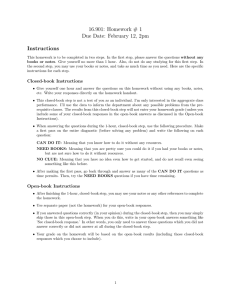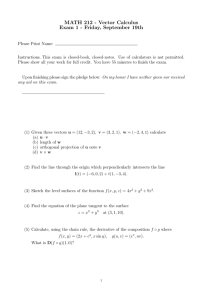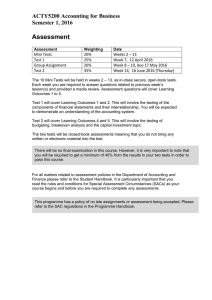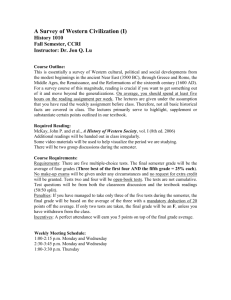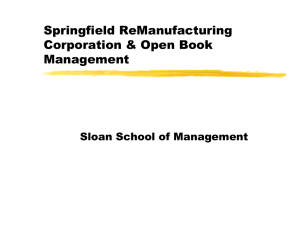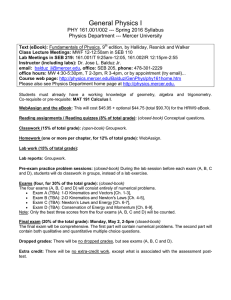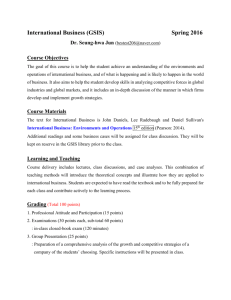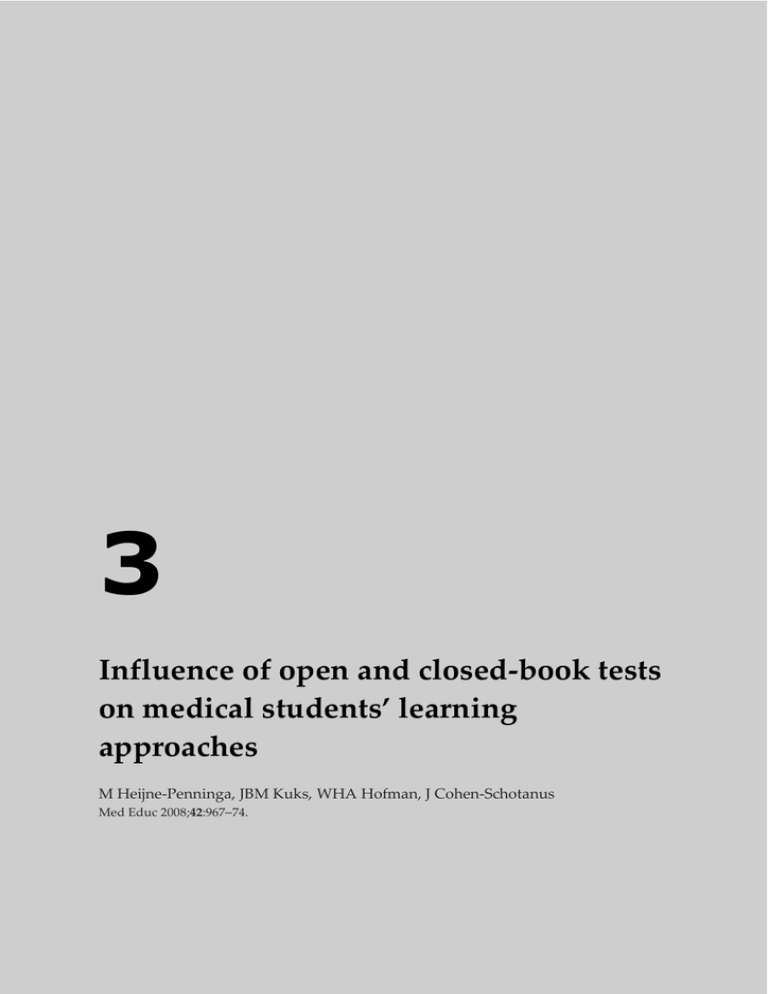
3
Influence of open and closed-book tests
on medical students’ learning
approaches
M Heijne-Penninga, JBM Kuks, WHA Hofman, J Cohen-Schotanus
Med Educ 2008;42:967–74.
Chapter 3
Abstract
Two learning approaches are consistently distinguished in literature: deep and
surface learning. The deep learning approach is considered preferable. Open-book
tests are expected to stimulate deep learning and to offer a possible way of
handling the substantial growth in medical knowledge. In this study we test the
hypothesis that open-book tests stimulate deep learning more than closed-book
tests.
Medical students in Years 2 (N = 423) and 3 (N = 306) participated in this
study. They evaluated their preparation for open and closed-book tests using the
test for Deep Information Processing (DIP). This questionnaire consists of 24 items
divided into three subscales: Critical Reading, Broaden one’s Context and Structuring.
A paired t-test was used to analyse the data.
Both cohorts scored significantly higher when preparing for closed-book
tests for the overall DIP score and on the Broaden one’s Context and Structuring
scales. Year 3 students also scored significantly higher on the Critical Reading scale
when preparing for closed-book tests. Gender differences were found: women
used deeper learning approaches than men.
Our hypothesis was not supported. In fact, the opposite was found: closedbook tests stimulated a deep learning approach more than open-book tests. Three
possible explanations are: deep learning is particularly necessary for remembering
and recalling knowledge; students feel more confident when preparing for closedbook tests, and students are more motivated to study for closed-book tests. The
debate on the concept of deep learning in higher education should probably be
renewed.
38
Influence on students’ learning approaches
Introduction
The body of medical knowledge is expanding rapidly.1 It is neither possible nor
even desirable for medical students to remember this growing volume of factual
information without the support of different reference sources. Adding open-book
tests to the assessment programme assists in handling this growth of knowledge in
medical education.2 Additionally, it is assumed that open-book tests stimulate a
deep learning approach,3-5 which is considered preferable to surface learning.6-9
However, the notion that open-book tests stimulate deep learning is mainly based
on opinion and logical conjecture and not on empirical data. The aim of this study
is to provide empirical evidence to support the notion that medical students use a
deeper learning approach when preparing for open-book tests than they do for
closed-book tests.
Learning approaches
Two kinds of learning approaches are consistently distinguished in the literature:
deep and surface learning.6-8 Students who focus on rote learning with the intention
of reproducing the learning material are using a surface approach.6,8 By contrast,
deep learning can be described as focusing on understanding by applying and
comparing ideas.6,8 A deep learning approach is considered preferable because the
intellectual processes valuable to medical students seem to be more closely linked
to this approach.9 Different labels are used to describe or measure deep learning in
the literature.10-12 The most important aspects of deep learning are the intention to
form a personal understanding of the learning material and an active engagement
and interest in the subject being learned.13 In summary, deep learning seems to be
characterised by three dimensions:
1) understanding: trying to understand the learning material by gaining an
overview and creating outlines and structure;
2) elaboration: relating the learning material to other sources and personal
ideas and questioning and using evidence critically, and
3) analysis: trying to clarify the learning material by searching for its major
points, finding reasons for what is being said and arriving at conclusions.
39
Chapter 3
Research has shown that learning approaches are highly sensitive to the learning
context, including the assessment programme.14-17 Students’ perceptions of the
learning environment influence their learning approaches,18 for example, the way
they perceive quality of education. It has been shown that clear learning objectives,
structure and the stimulation of independent learning have a positive relationship
with the deep learning approach, just as student perceptions of the relevance of a
subject.6,15,16 Poor assessment methods and a heavy workload correlate with a
surface learning approach.7 The impact on student learning seems to be truly
complex,19 and can vary between individuals and groups of students.18
Adding open-book tests to the assessment programme modifies the learning
context and may subsequently lead to a change in students’ learning approaches. As
open-book tests stimulate teachers to ask questions at higher cognitive levels,4
students may be encouraged to use deeper learning approaches, especially when
the need for recall is limited. When studying for open-book tests, students are able
to read and think rather than read and memorise. Therefore, it is expected that
open-book tests stimulate deep learning.3-4
However, we found only one study that confirmed this expectation.20 In this
study students were asked about their activities before and during open and
closed-book tests. According to the results, students preparing for open-book tests
tended to apply higher-order thinking and studied the course material in greater
depth. When preparing for closed-book tests, however, these students postponed
their study activities and memorised information. The participants in this study
were undergraduates whose assessment programmes did not regularly contain
open-book tests. The results are difficult to generalise to a medical setting,
especially in conditions where open-book tests are a regular part of the assessment
programme.
In summary, open-book tests can be of use in handling the expansion of the body
of knowledge. However, their influence on learning approaches has rarely been
studied. This study examines the impact of preparing for open and closed-book
tests on the depth of learning in a medical curriculum. The hypothesis tested in this
study is that open-book tests stimulate deep learning more than closed-book tests.
40
Influence on students’ learning approaches
Method
Context and Participants
At the University of Groningen every written knowledge examination in the
Bachelor of Medicine programme concerns theory delivered in a 10-week module.
Each module is examined in three sessions. Until 2003 it was common to test
students using closed-book tests only. Since 2003 all written examinations have
consisted of an open-book component that covers the entire amount of knowledge
to be studied preceded by a closed-book component concerning essential facts to
be learned by heart (which represents only a limited part of the material to be
studied).
To avoid confusion about the distinction between these essential facts and the
entirety of the theoretical knowledge set for the module, the theory of a module is
divided into core and back-up knowledge.2 Core knowledge is defined as
knowledge that every medical professional should know without needing to
consult reference sources. Back-up knowledge is defined as knowledge that
students need to understand and apply properly, with the use of reference sources,
if desired. Students are instructed to study the entirety of the literature set for the
module (in order to be able to work with it efficiently during the open-book
examination) and then see whether they are able to reproduce the core knowledge
(in order to be able to reproduce this by heart during the closed-book
examination).
The first part of each written examination comprises closed-book questions.
Once the students’ closed-book answer sheets are collected, reference books can be
opened for the second half of the examination, which contains open-book
questions. The examination lasts a maximum of 3 hours, with 1 hour available for
the closed-book questions. On average, examinations contain 48 open-book
questions and 80 closed-book questions. All examinations are multiple-choice in
format and are taken in class. During a previous research study the reliability and
difficulty of these types of tests were examined using generalisability theory.2 The
results of that study showed that the reliability of open and closed-book tests
varied between 0.71 and 0.85. The open-book test reliabilities were slightly lower
41
Chapter 3
than the closed-book test reliabilities, but still sufficient. The level of difficulty,
defined as an average percentage of correct answers, did not differ between these
two types of tests.
Medical students in Years 2 (N = 423) and 3 (N = 306) participated in this study.
They had been exposed to open and closed-book questions from their first year of
medical training. Students were informed that they were participating in a research
study, although the hypothesis tested in this study was not mentioned.
Design
In order to compare the influence of our new closed/open-book examination with
that of a solely closed-book examination on students’ learning approaches, we
decided to focus our study on four examinations each covering the literature from
a 4-week section of a module. Students were instructed to prepare for a closedbook examination in weeks 2 and 4 and for an open-book examination in weeks 1
and 3 (Table 1). Special care was taken to make sure that the literature for weeks 2
and 4 differed from that to be studied in weeks 1 and 3, while ensuring that both
sets of the literature were comparable in content and discipline, and equivalent in
level of complexity. The examination consisted of a closed-book section testing the
results of the study undertaken during weeks 2 and 4 and an open-book section to
test the achievements of weeks 1 and 3.
Table 1. Theory or information delivered each week and the assessment format
to be prepared for
Knowledge
Week 1
Week 2
Week 3
Week 4
Assessment
Open-book
Closed-book
Open-book
Closed-book
The instruction for the questionnaire about open-book test preparation was: How
did you prepare the knowledge presented in weeks 1 and 3 for the open-book test?
Concerning the closed-book test preparation, the question was: How did you prepare
the knowledge presented in weeks 2 and 4 for the closed-book test?
In this design students prepared both types of knowledge for both types of
tests to make sure we just examined differences between test formats only, rather
42
Influence on students’ learning approaches
than differences between types of knowledge. The examinations were part of the
regular assessment programme. The design was developed with the help and
approval of the Faculty Examination Board in such a way that the amount of
knowledge and questions did not overload the students.
Instrument
The questionnaire used in this study was the test for Deep Information Processing
(DIP).12 The DIP is a validated instrument and consists of 23 items (Table 2)
covering three deep learning dimensions: Critical Reading (understanding), Broaden
one’s Context (elaboration) and Structuring (analysis). The Critical Reading scale
consists of nine items (e.g. ‘When reading a text in preparation for this
open/closed-book examination, I understand the meaning of the text very
quickly’). The Broaden one’s Context scale consists of eight items (e.g. ‘When reading
a text in preparation for this open/closed-book examination, I compare what I read
with things I already know’). The last scale, Structuring, consists of six items, (e.g.
‘When reading a text in preparation for this open/closed-book examination, I make
notes of the most important issues’). All items were rated on a 5-point Likert scale
(1 = never, 5 = always). A total DIP score and a score for each scale were calculated.
Procedure
The questionnaires were presented to the students before the start of the
examination. They were given extra time to complete the two questionnaires. To
avoid order influences, half of the students from each year-group started with the
questionnaire about preparing for open-book questions, and the other half started
with the questionnaire about preparing for closed-book questions.
Analysis
The internal consistencies of the DIP and the three scales of the DIP were
calculated to indicate reliability. A paired t-test was used to distinguish differences
between open and closed-book test preparation. Differences between Year 2 and 3
students and between men and women were also analysed using the independentsamples t-test.
43
Chapter 3
Table 2. Deep Information Processing scales
Critical Reading
I attentively and critically look at the argumentation.
I understand the meaning of the text very quickly.
I cannot get an overview when the text is long.*
I read on even when I do not know a certain expression.*
I quickly distinguish facts from side issues.
I find it difficult to get an overview quickly.*
I assume difficult things without really understanding them.*
I cannot distinguish facts from side issues unless I read the text several
times.*
I keep on reading without really understanding the previous parts.*
Broaden one’s Context
I think of questions while I read.
I try to think of counter-arguments.
I try to relate new concepts to concepts that I already know.
I try to relate different courses.
I look for the how and why of statements.
I try to apply things in daily living.
I compare what I read with things I already know.
I think of examples myself.
Structuring
I try to find structure in a text by looking at the title and headlines.
I make notes on the most important issues.
I pay attention to titles and headlines.
I pay attention to the paragraph division of the text.
I write down my conclusions on a text.
I also look at other books to gain a broader view of a subject.
* these items are recoded
44
Influence on students’ learning approaches
To indicate the importance of the observed differences, effect sizes (ES) were
calculated using the formula of Rosnow and Rosenthal.21 The following
interpretation was applied: ES = 0.10 (small effect); ES = 0.30 (medium effect); and
ES = 0.50 (large effect).22
Results
Questionnaires were returned by 405 (96%) Year 2 students and 271 (89%) Year 3
students. About two-thirds of the respondents from both years were female. The
average age of the students in Years 2 and 3 was 20.5 years and 21.3 years,
respectively. Some respondents did not complete both questionnaires or skipped
some of the items. To handle the missing data, paired deletion was employed.
Therefore, n differs between the scales in Tables 3 and 4.
Table 3. Internal Reliability (α) for the Deep Information
Processing factors per measurement*
Year 2
CB
OB
Year 3
CB
OB
Critical Reading
.80
.77
.77
.73
Broaden one’s Context
.83
.83
.78
.82
Structuring
.73
.68
.71
.72
Total DIP score
.84
.83
.81
.81
* CB = closed-book; OB = open-book;
DIP = Deep Information Processing
The internal reliability of the DIP scales and the total DIP score per measurement
varied from α = 0.68 to α = 0.84 (Table 3), indicating generally sufficient
measurement precision.
Table 4 shows the DIP results for preparation for both test formats. Students scored
significantly higher on all scales and on the overall DIP score when reporting on
their preparation for closed-book questions. Only Critical Reading did not differ
significantly in Year 2 and had a low effect size in Year 3.
45
Chapter 3
Year 3 students used a higher level of deep learning than Year 2 students. These
differences were significant for the overall DIP score, for all the closed-book test
preparation scales, and for Critical Reading in open-book tests preparation (ES =
low).
Table 4. Paired t-test, closed-book versus open-book test preparation and
effect size forYear 2 and Year 3 students
CB
OB
N
M
S.E.
M
S.E.
t
P
ES*
377
29.8
.25
30.0
.25
-.885
.377
-
372
25.8
.25
24.8
.25
5.255
.000
.26
378
338
23.5
79.1
.23
.57
22.1
76.7
.22
.57
7.722
5.378
.000
.000
.37
.28
251
31.8
.28
31.2
.28
2.820
.005
.18
251
26.6
.28
25.4
.30
5.407
.000
.32
255
232
24.2
82.5
.29
.64
22.3
78.8
.30
.65
7.504
6.444
.000
.000
.43
.39
Year 2
Critical Reading
Broaden one’s
Context
Structuring
Total DIP score
Year 3
Critical Reading
Broaden one’s
Context
Structuring
Total DIP score
* effect size: low = .10; medium = .30 and large = .50
S.E. = standard error; ES = effect size; DIP = Deep Information Processing
CB = closed-book; OB = open-book
The results show significant gender differences (Table 5). Female students scored
higher on Structuring than males regardless of the assessment type. Year 2 women
also scored significantly higher than Year 2 men on the total DIP score when
preparing for open-book questions. Year 3 women scored significantly higher than
Year 3 men on the overall DIP score when preparing for closed-book questions.
Both the effect sizes are low.
46
Influence on students’ learning approaches
Table 5. Paired t-test, men versus women for closed-book and open-book,
DIP scores and effect size for Year 2 and 3 students
Males
Females
N
M
N
M
t
P
ES*
Critical Reading CB
Broaden one’s Context CB
Structuring CB
Total DIP score CB
121
124
123
118
30.1
25.8
21.4
77.5
265
264
267
250
29.6
25.8
24.3
79.7
.861
-.019
-6.093
-1.899
.390
.985
.000
.058
.30
-
Critical Reading OB
Broaden one’s Context OB
Structuring OB
Total DIP score OB
121
120
119
114
30.2
24.5
20.7
74.8
268
263
267
250
29.9
24.9
22.9
77.7
.471
-.727
-4.754
-2.491
.638
.468
.000
.013
.24
.13
Critical Reading CB
Broaden one’s Context CB
Structuring CB
Total DIP score CB
75
76
78
72
31.6
26.3
22.0
80.1
182
183
185
176
31.7
26.8
25.2
83.4
-.205
-.869
-5.299
-2.462
.838
.386
.000
.015
.31
.16
Critical Reading OB
Broaden one’s Context OB
Structuring OB
Total DIP score OB
76
76
73
71
31.4
25.2
20.7
77.7
181
178
183
171
31.0
25.3
23.0
79.0
.638
-.126
-3.494
-.937
.525
.900
.001
.350
.21
-
Year 2
Year 3
* effect size: low = .10; medium = .30 and large = .50
CB = closed-book; OB = open-book; DIP = Deep Information Processing;
ES = effect size
Discussion
The hypothesis that open-book tests stimulate a deep learning approach more than
closed-book tests was not confirmed. On the contrary, the opposite was found:
closed-book tests are more strongly related to a deep learning approach than openbook tests.
A first possible explanation is that students preferentially apply a deep
learning approach to structuring their learning material in such a way that they can
recall it faster, which is especially necessary for closed-book tests.23 They probably
do not realise that structuring and recalling are also important for open-book tests
47
Chapter 3
that require answers to a sufficient number of questions in a limited period of time.
Secondly, students’ perceptions of their ability to fulfil a task has a positive
relationship with deep learning.24 Perhaps students feel more confident when
preparing for closed-book tests than they do for open-book tests. Preparing for
open-book tests and using references during the tests seem to be difficult skills.25
Thirdly, as well as confidence, motivation has a positive influence on the level of
deep learning.24 Students are probably more motivated to study for closed-book
tests, which is connected to the levels of priority students accord to preparing for
both assessment types and their perceived relevance.26 They possibly consider
closed-book tests to be more important and thus accord less priority to preparation
for open-book tests, because they know they can always consult their references if
necessary. Moreover, in the present context, results for open-book questions can be
compensated for by results for closed-book questions, and the tests contained more
closed than open-book questions.
In the light of these possible explanations, it seems that if open-book tests are to
stimulate deep learning, special attention to student confidence and motivation is
required. A solution might be to train students in preparing for open-book tests
and using references effectively. Equalising the numbers of questions in both tests
may represent a second course of possible action. However, it should be realised
that answering an open-book test question probably takes more time than
answering a closed-book question. A third possibility concerns using open-book
questions exclusively instead of a combination of open and closed-book questions.
Open-book test preparation would thus have sole priority and would not have to
compete with closed-book test preparation. A fourth solution involves shortening
the time available for sitting an open-book test or increasing the number of openbook questions in a test. This could stimulate students to use a deep learning
approach because more efficiency in reference use would be required, which
concords with a deeper learning strategy.
The results also show a gender difference: women use deeper learning approaches
than men. Most studies of learning approaches do not report gender differences.
48
Influence on students’ learning approaches
The results of studies that examined gender differences are either inconsistent or
hard to explain.27,28 When reported, most studies in higher education have found
that women use a deeper learning approach than men, which is consistent with our
results.28 Female students are often reported as studying in a more organised
manner and as being better able to manage their studies effectively.28 This could
explain why they score especially highly on Structuring for open and closed-book
tests. Structuring was measured using items such as ‘I try to find structure in a text
by looking at the title and headlines’, ‘I make notes on the most important issues’
and ‘I write down my conclusions on a text’. However, the differences may also
result from men and women answering these questions differently. Byrne et al.
suggest that males fail to report their actual approaches to learning effectively.29
An interesting third outcome is that Year 3 students scored significantly higher on
deep learning than Year 2 students. Although the effect sizes were low, these
results confirm other outcomes.14,30 McCune and Entwistle indicated that Year 1
students were less well able to read learning material critically and develop
personal ideas than more experienced students. They were less able to move
beyond a basic understanding of the learning material.13 These differences can
probably also be found between students in Years 2 and 3. Furthermore, Year 3
students have more experience than Year 2 students in preparing for open and
closed-book questions. Their confidence is possibly greater and, therefore, also
their level of deep learning.24 It is possible that students develop their learning over
time and increasingly use a deep learning approach. An equally possible
explanation is that Year 3 students are more motivated to study because they are
closer to clerkships and to working as medical practitioners. As previously
discussed, motivation has a positive relationship with the level of deep learning
achieved.24
Strong points of this study include the fact that the hypothesis was tested by using
a validated and sufficiently reliable questionnaire. Furthermore, two large groups
of students participated in this study, the response rate was high and a crossover
design was used to control for possible order influences. A possible weak point is
49
Chapter 3
that students were concurrently preparing for open and closed-book tests. This
could have biased their responses to the questionnaires; however, the systematic
differences oppose this supposition. A second possible weak point is that this
study was performed at one university and within one faculty, although two
cohorts of students were used. Replication of this study in other disciplines may be
necessary. Thirdly, a questionnaire from 1996 was used. However, the way deep
learning is referred to in this questionnaire is comparable with its definition in the
current literature.
In this study, deep learning was described as the act of attempting to understand
the learning material throughout and to link the learning material to other
knowledge and personal experiences.12 However, research has shown that students
in different disciplines displayed differences in deep learning. For science students,
a deep approach appeared to require an initial concentration on details. For
humanities students, the deep approach involved working from the outset to
develop a personal understanding of the material.13 Perhaps the definition of deep
learning is not universal for students in different fields of study. Moreover, the
distinction between deep and surface learning was made some time in the 1970s.
As noted in the introduction, context plays an important role in influencing
student learning approaches, and today’s learning context differs substantially
from that of the 1970s. Nowadays, the body of knowledge is expanding rapidly
and knowledge is easily accessible. The casual observer is inclined to wonder
whether approaches such as those that involve selecting knowledge and finding
relevant knowledge at a specific moment are becoming increasingly important.
This transformed context also leads to different kinds of students. Presentday students have grown up with technology – they are members of the so-called
Net Generation.31 The characteristics and qualities of this generation seem to differ
from those of previous generations. For example, the Net Generation is
accustomed to multi-tasking: they surf the Internet while chatting with friends,
listening to the radio and composing a text. Students who have grown up with
computers deal with information differently compared with those of the past.31
50
Influence on students’ learning approaches
Perhaps the traditional definition of deep learning is no longer appropriate or
complete for today’s students.
In summary, students following today’s medical curricula have to cope with a
growing volume of knowledge in a context that differs substantially from the
learning environment of the 1970s. Open-book tests enable students and medical
curricula to handle this growing volume of knowledge. Although we did not find
that open-book tests stimulate deep learning in medical students more than closedbook tests, they may stimulate other important approaches and skills and could
nonetheless result in the outcome level that society currently requires.
Acknowledgements
The authors thank the students who participated in this study, as well as
Mrs J. Bouwkamp-Timmer for her support with the literature research and her
critical and constructive comments on the manuscript.
References
1.
2.
3.
4.
5.
6.
7.
Miflin BM, Campbell CB, Price DA. A conceptual framework to guide the
development of self-directed, lifelong learning in problem based medical
curricula. Med Educ 2000;34:299−306.
Heijne-Penninga M, Kuks JBM, Schönrock-Adema J, Snijders TAB, CohenSchotanus J. Open-book tests to complement assessment-programmes: analysis
of open and closed-book tests. Adv Health Sci Educ 2008;13:263–73.
Feller M. Open-book testing and education for the future. Stud Educ Eval
1994;20:235−8.
Bouman IN, Riechelman HW. Open book exams: aims, facts and future. Med
Teach 1995;17:240.
Smidt SR. Is it time to close the book on closed-book examinations? Med Health
R I 1999;82:285−8.
Newble DI, Entwistle NJ. Learning styles and approaches: implications for
medical education. Med Educ 1986;20:162−75.
Lizzio A, Wilson K, Simons R. University students’ perceptions of the learning
environment and academic outcome: implications for theory and outcome. Stud
High Educ 2002;27:27−50.
51
Chapter 3
8.
9.
10.
11.
12.
13.
14.
15.
16.
17.
18.
19.
20.
21.
22.
23.
24.
25.
52
Marton F, Säljö R. On qualitative differences in learning: I- outcome and
process. Br J Educ Psychol 1976;46:4−11.
Abraham RR, Kamath A, Upadhya S, Ramnarayan K. Learning approaches to
physiology of undergraduates in an Indian medical school. Med Educ
2006;40:916−23.
Entwistle N, McCune V. The conceptual bases of study strategy inventories.
Educ Psychol Rev 2004;16:325−45.
Tait H, Entwistle NJ, McCune V. ASSIST: a reconceptualisation of the
Approaches to Studying Inventory. In: Rust C, ed. Improving student learning:
improving students as learners. Oxford: Oxford Brookes University, Oxford
Centre for Staff and Learning Development 1997: 262–71.
Schouwenburg HC, Schilder AJE. Handleiding bij de Test voor Diepgaande Leerstof
Verwerking DLV’95 [Manual for the Test for Deep Information Processing].
Groningen: Studie Ondersteuning 1996.
McCune V, Entwistle N. The deep approach to learning: analytic abstraction and
idiosyncratic development. Paper presented at the innovations in Higher
Education Conference, 30 August – 2 September, Helsinki, Finland. 2000.
Available at: http://www.tla.ed.ac.uk/etl/docs/mccune2000.pdf.
Newble DI, Gordon MI. The learning style of medical students. Med Educ
1985;19:3−8.
Eley MG. Differential adoption of study approaches within individual students.
High Educ 1992;23:231−54.
Trigwell K, Prosser M. Improving the quality of student learning: the influence
of learning context and student approaches to learning on learning outcomes.
High Educ 1991;22:25−66.
Newble DI, Jaeger K. The effect of assessments and examinations on the
learning of medical students. Med Educ 1983;17:165−71.
Entwistle N, Tait H. Approaches to learning, evaluations of teaching and
preferences for contrasting environments. High Educ 1990;19:169−94.
Mattick K, Knight L. High-quality learning: harder to achieve than we think?
Med Educ 2007;41:638−44.
Theophilides C, Koutselini M. Study behavior in the closed-book and the openbook examination: a comparative analysis. Educ Res Eval 2000;6:379−93.
Rosnow RL, Rosenthal R. Beginning behavioural research: a conceptual primer. 5th
edn. Engelwood Cliffs, NJ: Pearson/Prentice Hall 2005.
Cohen J. A power primer. Psychol Bull 1992;112:155−9.
Vermunt JD, Vermetten YJ. Patterns in student learning: relations between
learning strategies, conceptions of learning and learning orientations. Educ
Psychol Rev 2004;16:359−84.
Bruinsma M. Effectiveness of higher education: factors that determine outcomes of
university education. [Dissertation] Groningen: GION, Rijksuniversiteit
Groningen 2003.
Broyles IL, Cyr PR, Korsen N. Open book tests: assessment of academic
learning in clerkships. Med Teach 2005;5:456−62.
Influence on students’ learning approaches
26.
27.
28.
29.
30.
31.
Seale JK, Chapman J, Davey C. The influence of assessments on students’
motivation to learn in a therapy degree course. Med Educ 2000;34:614−21.
Duff A. Access policy and approaches to learning. Account Educ 1999;8:99−110.
Mattick K, Dennis I, Bligh J. Approaches to learning and studying in medical
students: validation of a revised inventory and its relation to student
characteristics and performance. Med Educ 2004;38:535−43.
Byrne M, Flood B, Willis P. The relationship between learning approaches and
learning outcome: a study of Irish accounting students. Account Educ
2002;11;27−42.
Emilia O, Mulholland H. Approaches to learning of students in an Indonesian
medical school. Med Educ 1991;25:462−70.
Oblinger D, Oblinger J. Is it age or IT: first steps towards understanding the
net-generation. In: Oblinger D, Oblinger J. ed. Educating the net-generation. [S.l.]:
Educause 2005.
53

